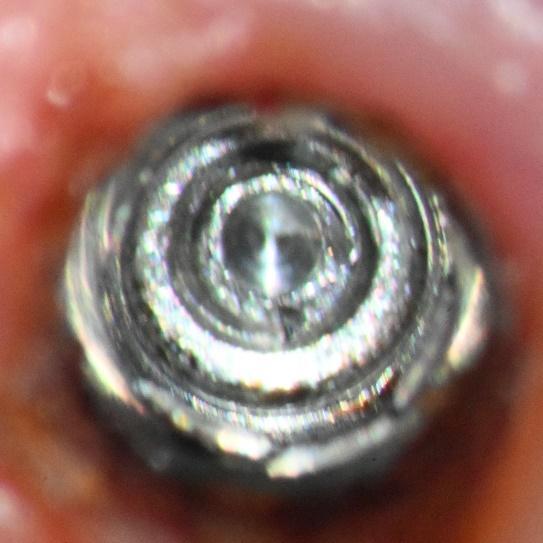

Iatrogenic Inclusion of Impression Material Resulting in an Early Abutment Screw Fracture
The patient presented for retrieval of a fractured abutment screw from a Straumann 4.8 BL implant in the #19 site. This implant was placed on 03.08.2023 and restored following routine integration. Evidently, the crown was delivered and that evening it felt loose to the patient. He went back the following day and when the screw was starting to be retorqued the screw either fractured then or was already fractured and was just spinning on the torque wrench driver. At that point, he referred the patient to our practice for assistance in recovering the fractured abutment screw fragment. There was no attempt to recover the fragment.
Following discussion of the retrieval process, the area was infiltrated with Septocaine, and a conservative tissue trim was completed to remove collapsed tissue off the implant top, which exposed the entire top circumference of the implant. The screw fragment was visualized under the microscope and was found to be non-mobile with both, an endodontic explorer, and a modified endo spoon. The first lead thread of the fragment was resting just above the first implant lead thread. Therefore, in my screw retrieval recovery algorithm this presents as a Type II case. (The complete screw recovery algorithm can be found on my website at mastrovichdnetal.com) A Type II case requires concentric mobilization, and this is accomplished with a concentric drilling technique to avoid implant thread damage. A custom precision drill guide system was fitted, and confirmation of concentricity was made following the use of a .9mm custom, left hand spot drill. Next a .8mm custom left hand drill was used and the fragment was drilled completely through. At this point it was noticed were was a reddish-purple material at the end of the screw fragment. A .8mm screw extractor was then engaged and the fragment was backed out without difficulty. Once the fragment was out it became apparent the material at the end of the screw was retained impression material. When and how it got there is currently a mystery. However, the mechanism of failure is not. Having the material fill up the screw channel could create a hydraulic effect as the solid, or even a liquid if the material was not set, would be somewhat compressed, but only so far, until it blocked the progress of the screw. Thread torque is the inevitable twist or torquing on the screw threads created by the friction in the threads and overall is not desirable. Total torque is the number on our torque wrench which gets decreased by the friction under the screw head with the balance becoming thread torque. If the end of the screw hits a blockage before the screw head seats, and therefore there is no head fraction, then total torque will equal thread torque. The screw is then more prone to fracture, generally just above the threads through the minor diameter of the screw. Following this discovery, the impression material was easily removed in small pieces with an explorer and the threads were confirmed to be clean by passing a M1.6x.35 tap through them. He was referred back to his restorative dentist for placement of the restoration with a new abutment screw.
– Charles A. Mastrovich, DDS












